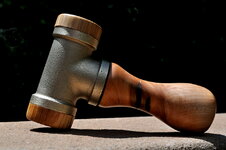monophoto
Member
Inspired by a video I saw some time ago, I recently decided to make a hammer.
The body of the hammer started out as a 3/4" brass plumbing 'T'. The handle was turned from a scrap of very hard and very dry firewood - I believe it was black locust but can't be totally sure. The faces are white oak. All of the wood is finished with boiled linseed oil.
The head is filled with bb's so that the hammer is a 'dead blow' design. Because the handle is so short (less than 6"), it's intended for applications that call for tapping rather than hard pounding.
The body of the hammer started out as a 3/4" brass plumbing 'T'. The handle was turned from a scrap of very hard and very dry firewood - I believe it was black locust but can't be totally sure. The faces are white oak. All of the wood is finished with boiled linseed oil.
The head is filled with bb's so that the hammer is a 'dead blow' design. Because the handle is so short (less than 6"), it's intended for applications that call for tapping rather than hard pounding.

